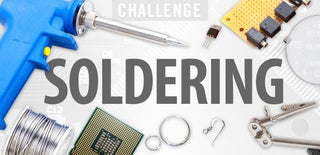Introduction: Bluetooth Battery Portable Speaker
As with most of my projects, the inspiration was borrowed and the final project is different then what I had originally planned. I started out with wanting to make an ammo can speaker. Unfortunately (actually fortunately), I didn't have a 50 cal case. My can was too small. I decided to use a plastic ammo can and it sounded like crap. Having purchased my supplies, I decided to build a wood box. And here we are. This speaker sounds really good and is capable of some surprisingly high output, and easily lasts a day. It can connect with any Bluetooth device at the push of a button.
This project takes basic carpentry and electronic skills including soldering. Nothing too hard or demanding. Except for the box, everything is off the shelf. And for you speaker builder's out there, I did not computer the enclosure volume. I also did not make separate left and right chambers. This was a quick build and serves my needs. I would not use this for critical listening but for streaming Bluetooth? It rocks. For those who want the best available, there are many online resources about speaker enclosure design and build.
Step 1: Supplies
Here is what I used:
Amp - Lepai LP - 2020a. Ebay $20
Speakers - Kenwood DFC1065 Amazon $18.81 (they were used). Any 4" car speaker will work. You should research and get one with the highest sensitivity. These are 90 db. 91 or 92 would be better.
IEC power connector $2.72. http://www.amazon.com/gp/product/B00917Z96S?psc=1&...
Power Switch $2.33. http://www.amazon.com/gp/product/B00MVN6WLU?psc=1&...
12v battery $20.79. http://www.amazon.com/gp/product/B0009GIKNE?psc=1&...
Volt Meter. $9.80. http://www.amazon.com/gp/product/B00CK3P20S?psc=1&...
Bluetooth Car Kit $18.99. http://www.amazon.com/gp/product/B00RSZWK1W?psc=1&...
12v to 5v module $2.99. http://www.amazon.com/gp/product/B00BMIVFK8?psc=1&...
Battery Charger $10.94. http://www.amazon.com/gp/product/B001G8AIMU?psc=1&...
Momentary Contact Button. Radio Shack. $3.99
Total price was around $100 + misc. hardware, parts (fuse), and paint.
Step 2: Build the Box
Sorry, no how to pictures here. This is a basic box. It was constructed of particle board. I would not recommend particle board but I knew I was going to finish with truck bed liner. You can finish with paint but you are going to spend a lot of time on the finish. If paint is were you are going, I would use MDF or birch (1/2").
You will need a saw and some sort of tool to make the cutouts (saber saw or router). You can always have the the lumber store (HD or Lowes) cut your box dimensions for you. Glue all of the pieces except the back.
The speakers should come with a template.
Step 3: Adding the Components
The only major obstacle I encountered was the Bluetooth receiver. My original design had a top that was easily opened. This box is sealed close. I needed a way to be able to trigger the pairing circuit. I took the Bluetooth apart and found that I could complete the circuit by soldering wire to each side of the micro switch. These are connected to a momentary contact switch. Need to pair? Push the button on the front. My soldering skills being what they are, I enclosed the connection with a dab of hot glue to hopefully add some strength. If I were to do it over again, I would have gone with a Bluetooth module instead of an already manufactured unit. Learning moment.
If that is a stumbling block, you could always mount the Bluetooth receiver on the exterior.
For the battery, I simply glued in extra wood to make a holder and used wire to hold in place. If you look at one of the battery supports, you will see 2 bolts. These are the power rails. 1 for positive, 1 for negative. There are many different ways to do this including just twisting all the wire together with wire nuts (I would not recommend).
For the smaller components, I just applied a bit of hot glue to hold them in place.
For the battery charger, I made a short cord from the power connector to a female plug and plugged the battery charger into that.
For the 12v to 5 module, ran 12v from the battery (via switch) to the module, then plugged the Bluetooth into the usb output.
The basic wiring goes something like this:
Speakers, left and right to the left and right terminals on the amp. I tinned these because it's the anal thing to do.
With the exception of the battery charger, all the electrical components are wired to the bolts. The positive from the battery passes through the switch to feed the positive bolt. The battery charger is wired directly to the battery so it can be charged when the speaker is turned off.
NOTE: make sure you fuse the positive to your battery. Just saying.
Step 4: Finishing Touches
I placed rubber feet on the bottom. The back is removable. There is a handle on top for transportation.
Since the amp controls are in the box, you will probably have to open and close it a few times to get things set just right. I am running volume around 70% with a touch of bass and treble. My audio app on my phone has a equalizer for fine tuning.
Enjoy.

Participated in the
Soldering Challenge













